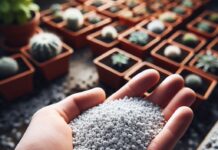Amending clay soil is the process of adding organic matter to a previously worked, dry, or barren garden or landscape. The soil will become enriched with microorganisms that help break down the manure and nutrients.
Amending clay soil is often needed since most are not blessed with an ideal soil to work with. Since you are stuck with the hand you are dealt, you may have to work quite diligently in order to upgrade the soil. Whether you have a little or a lot of clay, you can add organic matter to create a perfect starting point.
Clay Has Potential
Before you attempt to manage your garden‘s clay soil, it helps to understand a bit about the background of soil mineralogy. The soil is made up of silt, sand, and clay particles with the clay particles being the smallest, silt being the intermediate-sized and the largest particles are sand. Amending clay soil is important because clay particles are stacked sort of like a sandwich then almost glued together by an electrochemical force. The horizontal arrangement of the clay particles creates a large surface area.
Individual clay particles hold a negative charge and have the ability to attract, as well as hold onto and absorb charged elements that are positive such as potassium, ammonium, magnesium, and calcium. Clay soils have a lot of potential because they are quite fertile, having the ability to absorb necessary plant nutrients.
Strategies
Amending clay soil demands short-term and long-term strategies. The initial goal should be focused on adding the greatest amount of organic matter as deep as you can because applying them to the soil will improve the structure that helps to improve the health of the soil.
Your long-term strategy will be to attempt to build humus and organic carbon to promote nutrient cycling. This is done through consistent applications of manure, compost and organic matter.
Building organic matters help with amending clay soil in a couple of different ways. The organic matter separates clay particles and coats soil particles. More importantly, the microorganism that degrades the organic matter actually produces byproducts that are called glomalin. These byproducts bond the individual clay particles together. This particle aggregation in amending clay soil reduces crusting, erosion, and runoff and increases the water infiltration rate.
Organic matter, even in large amounts that are incorporated in the soil is going to break down rapidly. Any remaining organic matter will more than likely resist any further degradation for many years, even decades. However, any stable increases, called humus will occur very slowly. Therefore, any stable organic matter increase needs to be a long-term goal.
Don’t Disturb The Clay
When amending clay soil, it is advised to incorporate organic matter deeply and regularly, especially in the beginning while you are trying to whip the clay into shape. Aggregating stability, soil particle aggregation, drainage, water holding capacity, plant root growth, and nutrient retention all become increased after you incorporate organic matter.
Major losses of organic matter in the soil content can often take place if the soil is inverted by tillage. Extensive tillage will stimulate microbial activity which basically gives them an appetite so once your clay becomes friable you should reduce tillage. Since the soil is undisturbed, fertilizers will not homogenize within the tillage layer. Therefore, plant feeder roots tend to proliferate only in the fertile top two inches of the soil.
What Is Tilth?
When amending clay soil it is helpful to understand that tilth is the soil’s physical condition related to the ease of tillage, ease of seedling emergence, seedbed quality, and deep root penetration. Soil that is well-drained, takes in water rapidly, does not crust, does not make clods, and facilitates aeration is referred to as having good tilth. With a proper management strategy, a good tilth is obtainable when amending the clay soil.
How To Improve Clay Soil With Lime
If the soil in your garden is are clay-based then it is quite obvious that such soil would be too acidic for optimum plant growth. The pH scale runs from 0 to 14, with measurements in the 0 to 7.0 range being acidic, and those above 7.0 are alkaline. A pH of 7.0 is neutral. The pH of your soil is so important to plant growth because it determines the availability of almost all essential plant nutrients.
When soils become too acidic, certain nutrients become less available (phosphorus in particular), beneficial soil bacteria are less active, and certain elements — like aluminum and manganese — can become toxic. Not to mention the fact that your plants simply won’t perform their best. This is true no matter what you are growing; veggies, lawns, perennials, etc.
In such a situation you should apply lime to raise the soil’s pH and make it less acidic. Your objective should be to adjust the pH to 6.5. With this chemical composition in soil, the optimum nutrients can be ensured.
Many plants grow well with acidic soils and these include evergreens, rhododendrons, azaleas, and blueberries. Apart from this, a big majority of the plants growing in your vegetable patch need a pH of about 6.5 to maximize their yields.
A soil test will let you know if your soil’s pH needs to be adjusted and what should be the quantity of lime that should be added to the soil of your garden. Ideally, you should go for a soil test every two years and adjust your soil’s pH value.
The soil test will help you understand which type of lime material you should use. Calcitic lime is mined from natural limestone deposits and crushed to a fine powder. It also is called aglime or agricultural lime and supplies calcium to your soil as it adjusts the pH. Dolomitic lime is derived in a similar manner but from limestone sources that contain both calcium and magnesium. If your soil test came back showing high levels of magnesium, use calcitic lime. If the test shows a magnesium deficiency, then use dolomitic limestone. Clay soils tend to hold onto magnesium so more often than not, calcitic lime is the more appropriate choice for gardeners.
Pelletized calcitic lime is created by taking the finely pulverized particles of lime and binding them together with a binder compound to form small pellets that are much easier to spread than powdered lime products and will keep you from getting covered with dust. Uniform coverage is very important as lime is insoluble and can’t move around within the soil.
Skipped areas won’t have an effective pH change, and overlapped areas will undergo a more drastic pH change and wind up with potential trace element issues. To cover the area evenly, spread half the pelletized lime in one direction over the entire area, then apply the rest in a perpendicular fashion, creating a crisscross pattern.
Pelletized lime is a little expensive but its use is more convenient. If your soil test recommends the application of crushed agricultural lime, then the application rate for pelletized lime is lower. A 1:10 ratio is the rule of thumb. Meaning you need 10 times less pelletized lime than agricultural lime to garner the same pH change. So if your soil test recommends adding 100 pounds of agricultural lime, add 10 pounds of pelletized.










